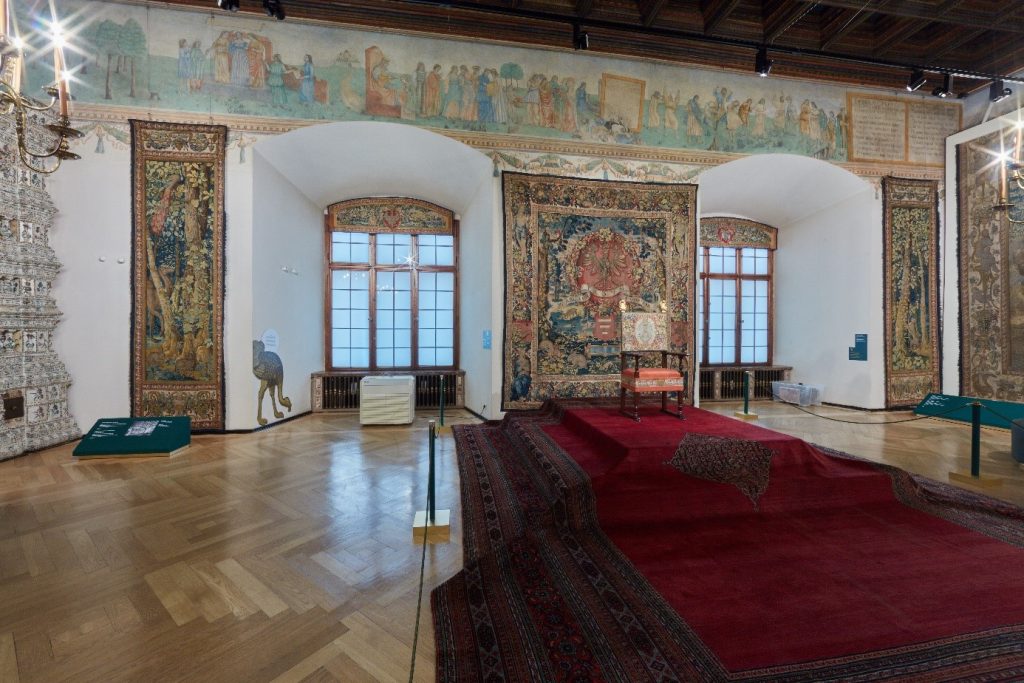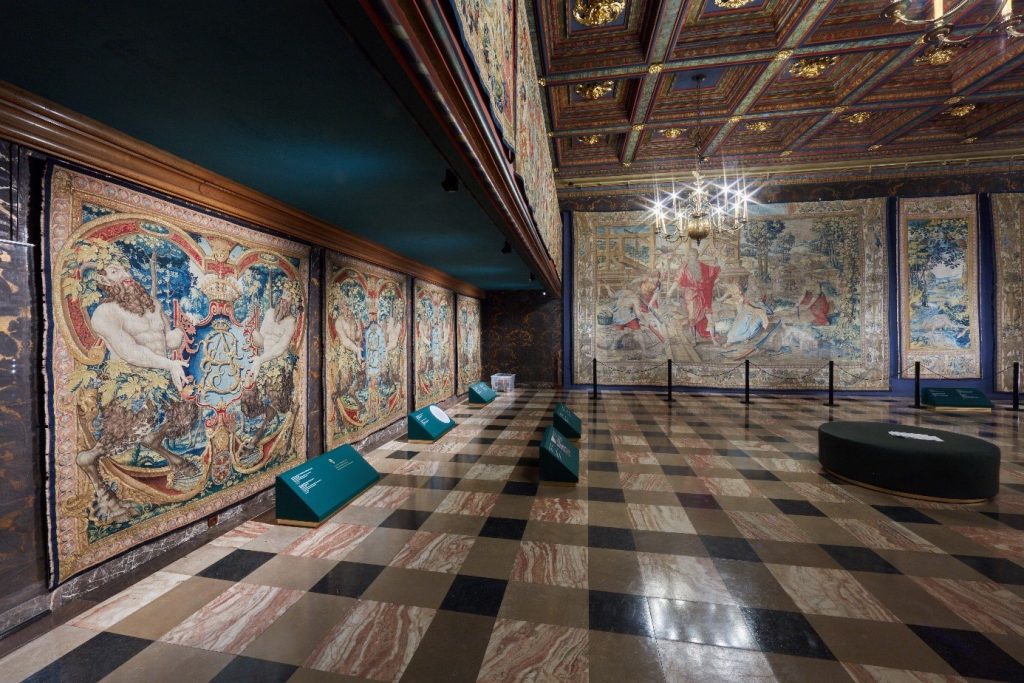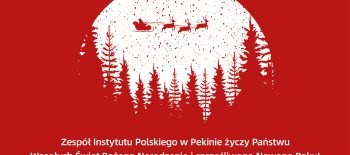They were hidden away from the Swedes, plundered at Catherine of Russia’s command, taken away on a boat three days before the Germans entered Cracow in 1939. Evacuated to Romania on September 18, then to France, and finally through England to Canada. At last, they are back. All of Sigismund Augustus’s tapestries preserved in Poland will now be displayed in the Wawel Royal Castle. In the history of the Jagiellonian residence, it is the only display of the whole preserved collection in the interiors for which the tapestries were created. The All the King’s Tapestries. Homecomings 2021-1961-1921 exhibition will be on view from March 18 through October 31. It is accompanied by the works of two distinguished contemporary artists: Mirosław Bałka and Marcin Maciejowski.

THE COMMISSION OF THE POLISH KING
The 16th-century audience was impressed with the tapestries’ sizes and the sparkle of gold and silver threads. The contemporary audience standing before biblical tapestries will discern, among other things, references to the masters of the Italian Renaissance – Raphael and Michelangelo. Before us, there are 137 royal tapestries captivating with their exquisite craftsmanship.
Among them are 19 monumental figurative fabrics depicting scenes from the Book of Genesis (Paradise Bliss – 189 in x 336 in, Animals Entering the Ark – 187 in x 312 in, The Building of the Tower of Babel – 190 in x 320 in), 44 verdures depicting landscapes and animal scenes (An Otter with a Fish in its Mouth and Fantastic Reptiles, A Unicorn-Giraffe and a Lynx, Stork and rabbits), 42 armorial tapestries (a grotesque with coats of arms of Poland and Lithuania and the figure of Ceres) and also small furniture upholstery and fabrics for decorating window recesses. Visitors did not have an opportunity to see many of these before.
“The creation of such an extensive tapestry collection in 1550–1560 in Brussels, commissioned by one ruler, is unprecedented in Europe. It is the biggest of its kind private – royal undertaking, arising from Sigismund Augustus’s passion for collecting. He collected, among other things, jewellery and works of handicraft. I am glad that we have returned to a fine tradition of organising exhibitions in historical spaces – representative and private chambers”, explains Jagiellonian University professor Andrzej Betlej, PhD, Director of the Wawel Royal Castle.

A JOURNEY THROUGH TIME AND SPACE
The exposition creates the atmosphere of castle interiors ceremonially decorated with tapestries, just like it used to be done in the past for special occasions. It also narrates the story of the conservators’ arduous work as they struggled with the effects of damage that had affected the tapestries during their turbulent history.
Since their return from Russia in 1921, a lengthy tapestry preservation process has begun. “Most of all, it is a significant work of Wawel conservators. In the Senators’ Hall, where armorial tapestries are displayed, you can also view a recently restored tapestry. It ‘regained’ its colours to a certain extent; it stands out from the other tapestries. I can say that it will be possible at the exhibition, thanks to particular means, to see some tapestries’ original colour schemes!”, says Andrzej Betlej, PhD.
However, the Director of the Wawel Royal Castle underlines that the concept of the exhibition, contained in the word “homecomings”, is surprising and inapparent. For in a reverse narrative, we will begin in contemporary times and then follow the next homecomings of the tapestries: in the years 1961 and 1921.
The contemporary touch of the exposition is created by the works of Marcin Maciejowski and Mirosław Bałka. “We want to show that Sigismund’s tapestries inspire contemporary artists. Marcin Maciejowski created his first painting that referred to the tapestries during his studies at the Academy of Fine Arts. He has now offered us a new piece of work, “A Visit to Wawel”. Mirosław Bałka prepared – with our exhibition in mind – two installations. We will see ‘Three Rays’ in the Wawel Castle’s courtyard. The second installation, called ‘Passport’, will open the exposition along with Maciejowski’s painting”, the Director of the Wawel Royal Castle says.
The exhibition is complemented by archival photographs showing the royal tapestries in surprising socio-historical contexts. We will see, among others, a picture of Brigitte Helm – the star of the film Metropolis (1927) directed by Fritz Lang, as she visited Wawel and admired Sigismund’s collection.

HOMECOMINGS 2021-1961-1921
A symbolic return of Sigismund Augustus’s tapestries to the Wawel Castle exhibition has been planned for 2021 intentionally, on the crucial anniversaries of two earlier homecomings. On March 18, 1961, an important display of the royal tapestries was held in the castle chambers to celebrate their return from Canada, where they had found shelter after many years of wandering through war-torn Europe.
The second of the eponymous homecomings was made possible by a peace treaty signed one hundred years ago, on March 18, 1921, in Riga. The treaty that sealed Poland’s victory in the war with Soviet Russia facilitated the revindication of thousands of works of art and other pieces of cultural property taken to tsarist Russia during the Partitions of Poland. The treaty also sanctioned the return of Sigismund Augustus’s tapestry collection, looted during the third partition in 1795.
The exhibition at the Wawel Castle not only commemorates the moments of the collection’s homecomings, but is also dedicated to people who rescued the tapestries and made it possible for them to be returned to the castle, among others: to Stanisław Świerz-Zaleski, Józef Krzywda-Polkowski, Jerzy Szablowski, Witold Małcużyński, and also to the people who fought for their revindication from Russia – Aleksander Czołowski and Marian Morelowski. We wanted to mark their devotion to the search for the tapestries, their endeavours to retrieve the treasures and care for them. This is why, apart from holding the exhibition, we decided to commemorate these distinguished people with a special memorial which will be revealed during the vernissage. “The exhibition will be held for half a year. Still, I would like it to be remembered forever – as a monument of the importance of the royal foundation, a commemoration of those who built the collection and those who cared for it for centuries. We will not let it be forgotten. For this purpose, we have published several books on the tapestries: the republication of the catalogue, a new collection of studies and an album in eight language versions. Of course, there is also the exhibition catalogue”, Andrzej Betlej, PhD, acknowledges.

MASTERPIECES IN THE GENRE
It is worth noting that the tapestries’ creators drew their inspiration not only from the works of the greatest artists but also from bestiaries and floristic and zoological compendia. Michiel Coxcie, the author of the biblical tapestries projects, was referred to as the “Flemish Raphael”. The Wawel tapestry collection formed the so-called first edition, a model for replicas and travesties that came later.
The collection of Wawel Tapestries was woven in the years 1550–1560 in excellent workshops in Brussels, the global metropolis of tapestry art of those times. The fabrics were made from wool, silk and silver threads or gilded silver threads. The masterpieces designed by the authors of cardboard paintings were created at the request of King Sigismund Augustus as part of a collection comprising approximately 160 tapestries intended for the decoration of the Wawel Royal Castle. It is the most extensive set of this type of fabrics that has ever been made at the request of one person. Curators and Authors of the All the King’s Tapestries. Homecomings 2021-1961-1921 exhibition: Magdalena Ozga, Magdalena Piwocka, Jerzy Holc.
PROGRAMME OF EDUCATIONAL ACTIVITIES
Unique value (and a novelty in the history of organising exhibitions at the Royal Wawel Castle) is attached to the educational programme, which is integrally linked with the exhibition.
Details: www.wawel.krakow.pl.
Co-funded by the Minister of Culture, National Heritage and Sport.
Press contact:
Urszula Wolak-Dudek
Spokesperson for the Wawel Royal Castle
Tel. +48 513 867 147
E-mail: urszula.wolak@wawelzamek.pl



